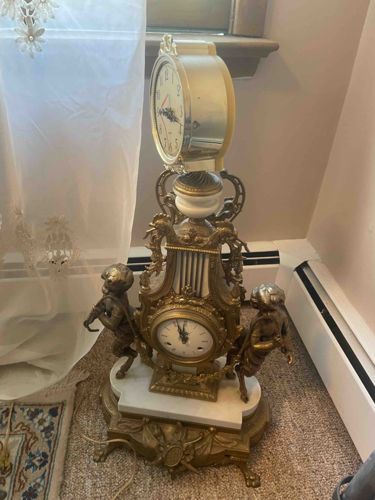
Gilt Bronze and Marble Dual Mantel Clock with Putti Figures
This is a substantial and ornate mantel clock, likely of French origin, dating to the late 19th or early 20th century, possibly in the Neoclassical or Rococo Revival style. It features a dual-clock design, with one clock prominently displayed on the upper section and another smaller dial integrated into the main body. The primary material appears to be gilded bronze or brass, exhibiting a rich, possibly original, golden patina with areas of wear and darkening consistent with age, particularly in recessed areas. The base of the clock is a rectangular block of polished white marble, which shows some veining typical of natural stone, and could benefit from cleaning. The overall construction is highly decorative, featuring intricate scrolling acanthus leaves, floral motifs, and classical architectural elements. Two putti or cherubic figures, one on each side, are attached to the central clock structure, adding to its elaborate design. These figures appear to be cast metal. The clock faces are white with black Roman numerals, and the hands appear to be black or dark-colored; the upper clock has a visible second hand. The craftsmanship indicates a high-quality manufacture, with finely detailed casting and assembly. There are no immediately obvious significant damages such as large chips or breaks, though the gilding shows expected wear and some accumulation of dust or grime in the intricate crevices. The movement of both clocks would need to be inspected to ascertain their working condition and manufacturer's marks, which are not visible in the image. The unique aspect is the dual clock design, setting it apart from more common mantel clocks.
AI-Generated Appraisal Disclaimer
Estimated Value
$2,800 - 3,500
Basic Information
Category
Timepiece/Decorative Arts
Appraised On
December 7, 2025
Estimated Value
$2,800 - 3,500
Item Description
This is a substantial and ornate mantel clock, likely of French origin, dating to the late 19th or early 20th century, possibly in the Neoclassical or Rococo Revival style. It features a dual-clock design, with one clock prominently displayed on the upper section and another smaller dial integrated into the main body. The primary material appears to be gilded bronze or brass, exhibiting a rich, possibly original, golden patina with areas of wear and darkening consistent with age, particularly in recessed areas. The base of the clock is a rectangular block of polished white marble, which shows some veining typical of natural stone, and could benefit from cleaning. The overall construction is highly decorative, featuring intricate scrolling acanthus leaves, floral motifs, and classical architectural elements. Two putti or cherubic figures, one on each side, are attached to the central clock structure, adding to its elaborate design. These figures appear to be cast metal. The clock faces are white with black Roman numerals, and the hands appear to be black or dark-colored; the upper clock has a visible second hand. The craftsmanship indicates a high-quality manufacture, with finely detailed casting and assembly. There are no immediately obvious significant damages such as large chips or breaks, though the gilding shows expected wear and some accumulation of dust or grime in the intricate crevices. The movement of both clocks would need to be inspected to ascertain their working condition and manufacturer's marks, which are not visible in the image. The unique aspect is the dual clock design, setting it apart from more common mantel clocks.
Get Your Items Appraised
Instant estimates of your treasures with AI-powered instant appraisals